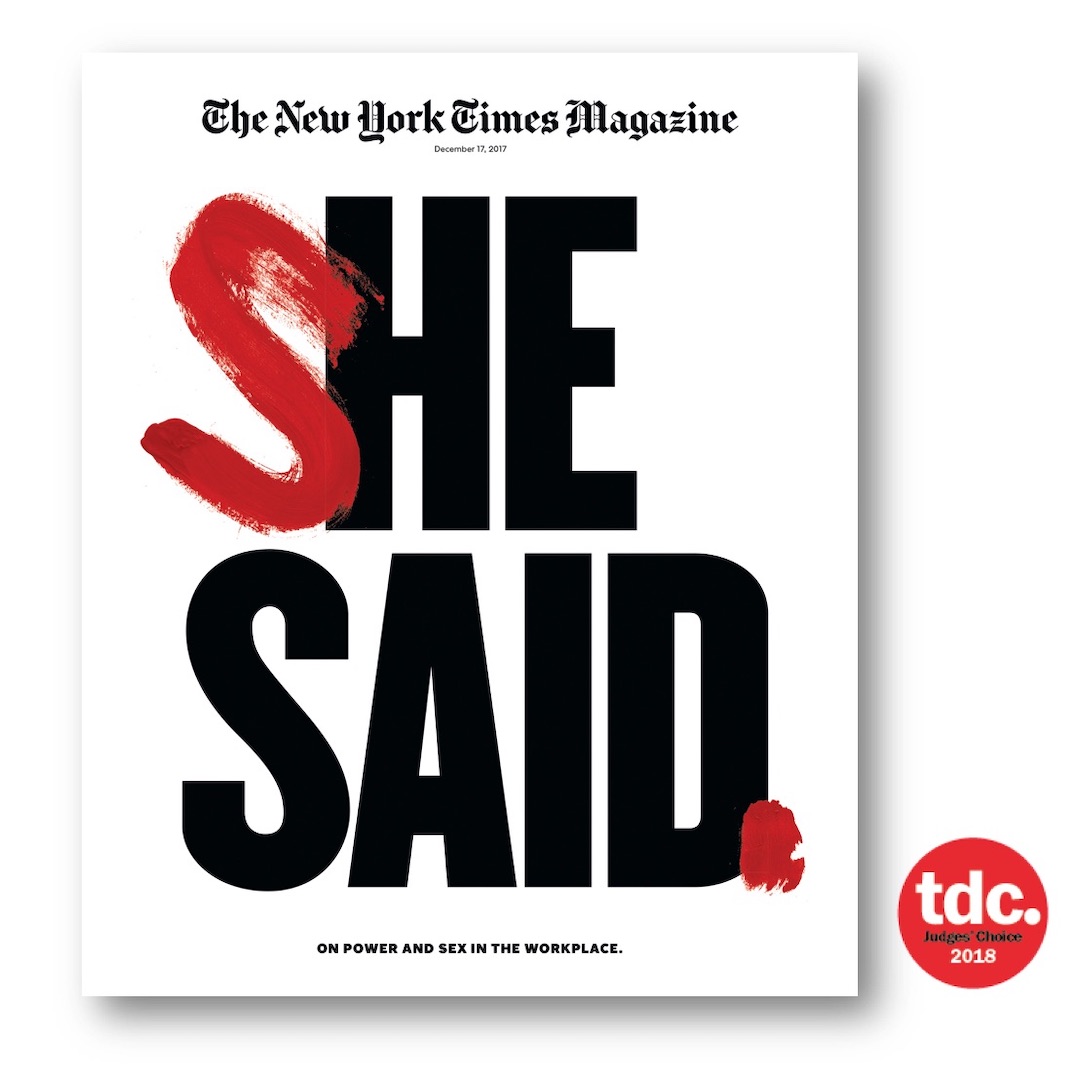
This year, each of our eleven TDC competition judges chose their favorite from all the entries. Susan Sellers chose the dramatic The New York Times Magazine cover created Gail Bichler, Matt Wiley, and Jessica Walsh.
This award-winning design is currently on display at the Dom Słów-Izba Drukarstwa (House of Words-Print House) in Lublin, Poland through December 31.
About the “She Said” NYT Magazine Cover
- Design Direction: Gail Bichler, New York
- Art Direction: Matt Wiley
- Illustration: Jessica Walsh
- URL: nytimes.com/section/magazine
- Publication: The New York Times Magazine
- Principal Type: Handlettering
 The New York Times Magazine December 2017 cover created by Gail Bichler, Matt Wiley, and Jessica Walsh.
The New York Times Magazine December 2017 cover created by Gail Bichler, Matt Wiley, and Jessica Walsh.
Designers’ statement: “For the cover of our issue on power and sex in the workplace, we played off a phrase that is used to discredit a women’s side of the story: “He said/she said.” Jessica Walsh tried many versions of the lettering – we wanted the S to feel urgent and angry. The blood red scrawl stood out in stark contrast to the formality of the type and you could feel the hand of the writer viscerally. Adding the period at the end gave women the last word. It’s simple, graphic and you get it right away.“
Comments by Communications Design Judge Susan Sellers
“Competitions tend to be riddled with typographic flourish, demonstrations of visual prowess ultimately finessed to impress designers themselves. All that style and beauty can be blinding, not much stands out in a field of hundreds of entries. It begs the question: Why? What’s all this for?
This design gets straight to the point. It demonstrates that design has a role to play in the urgent and critical debates of our time. The power of typography here is less about labor and craft and more the careful selection of words, a specific phrase with a specific history, represented through a spare yet striking typographic gesture.
The phrase “He Said, She Said” was highly politicized in the nineties, the era of the Anita Hill-Clarence Thomas hearings and later the Monica Lewinsky testimony. Originally potent with the debate and the implications of gender difference and bias, its excessive use — along with status quo court decisions, an aborted impeachment, and public complacency — exhausted its pique. Dulled down and docile, it was left to stand in for “irreconcilable dispute.”
Now, in this raw typographic collision, the designer reinvests the phrase with tension, difference, and debate. And frustration. And anger. It’s not neutral anymore. This typography doesn’t aspire to innovation or newness. Rather it takes on the most basic yet critical potential of the discipline — to call out, to question, and reach everyone fast. It’s efficiency, responsiveness, and urgency that is important here. Here we see design’s essential ability to reconnect words with truth and prompt action.”
 Susan Sellers portrait.
Susan Sellers portrait.
About Susan Sellers
Susan is a founding partner and Executive Creative Director at 2×4, a design firm that focuses strategy, design and brand development for forward-thinking creative brands and organization globally. Sellers views design as inquiry into the ideas and values implicit in the built environment, an elaborated journalism that unpacks and retells the world in evocative, informative, immersive experiences. Her work spans the urban, cultural and commercial integrating print, screen and architecture. From 2012 to 2016, Sellers served as Head of Design at The Metropolitan Museum of Art, leading design for the opening of the landmark Marcel Breuer Building, The Met Breuer, as well as exhibitions and the museum’s new brand identity. Sellers is Senior Critic in Graphic Design at Yale School of Art in New Haven, Connecticut. Sellers received a B.F.A. in graphic design from the Rhode Island School of Design in 1989 and an M.A. in American Studies from Yale University in 1994.